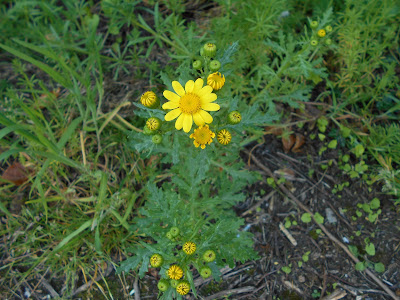I have already mentioned Neuroterus quercusbaccarum (My blog, 'Rolling our sleeves up', 18 May). This is a curiosity in that this tiny wasp will induce the production of differently-shaped galls depending on where and when the attack occurs. The photograph shows the gall produced on the leaf of a Pedunculate Oak, Quercus robur.
 |
| Neuroterus quercusbaccarum. Gall on an oak leaf in Byfield Pocket Park |
Neuroterus quercusbaccarum will also form a Currant Gall on catkins but Andricus grossulariae forms a very similar gall also on catkins. A specimen on a Turkey Oak, Quercus cerris, outside the village hall in Byfield, Northants will require further examination to establish which of the two species is involved.
 |
Neuroterus quercusbaccarum or Andricus grossulariae? Turkey Oak in
Byfield, Northants. 30 May, 2018
|
A gall is an abnormal growth on a plant consequent on an attack by another organism and involves some sort of swelling or thickening of the tissues and discoloration is common. They may not be as obvious as the example shown above and may take many forms. Ash tree, Fraxinus excelsior, leaflets are frequently attacked. This violet-purple roll on the edge of a leaflet is the work of a psyllid bug, Psyllopsis fraxini. It is exceedingly common and sometimes very disfiguring yet little serious harm appears to result.
 |
A psyllid bug, Phyllopsis fraxini, causes this rather distinctive gall on
ash tree leaflets. Park Leys, Daventry. 29 May, 2018
|
A rather odd gall on poplars is that formed by an aphid, Pemphigus spyrothecae. It causes the leaf petiole to form a spiral of two or three twists and apparently only attacks Black Poplar or one of its hybrids. Here it is affecting Lombardy Poplar, a fastigiate form of Black Poplar, in Byfield, Northants.
 |
The gall of Pemphigus spirothecae on 'Lombardy' Poplar. Byfield,
Northants. 30 May, 2018
|
Anyone who cares to examine the leaves of Common Lime, Tilia x europaea, will almost certainly find galls. A dozen or so organisms are involved but perhaps the most frequent one is that induced by the mite, Eriophyes tiliae. I recently counted over twenty galls on a single leaf.
Besides galls a leaf will frequently exhibit mines, usually formed by insect larvae tunnelling through the leaf. A rather typical example is this mine on a lilac, Syringa vulgaris, caused by a moth, Gracillaria syringella. The mine starts as a discolored patch but eventually the leaf becomes grossly distorted and curled at the edges. The moth bears the unexciting name of The Common Slender and will also attack privet and ash trees - not surprising given that all these three species are all in the Olive Family, Oleaceae.
 |
The galls of Eriophyes tiliae on Common Lime. Byfield, Northants.
30 May, 2018
|
Besides galls a leaf will frequently exhibit mines, usually formed by insect larvae tunnelling through the leaf. A rather typical example is this mine on a lilac, Syringa vulgaris, caused by a moth, Gracillaria syringella. The mine starts as a discolored patch but eventually the leaf becomes grossly distorted and curled at the edges. The moth bears the unexciting name of The Common Slender and will also attack privet and ash trees - not surprising given that all these three species are all in the Olive Family, Oleaceae.
 |
The Common Slender is the micro-moth responsible for this damage to
the leaves of lilac. Park Leys, Daventry. 29 May, 2018
|
There seem to be very few plants fortunate enough to be free of attacks by one insect or another. Even the humble buttercup is victim to the larvae of several insects. Here Meadow Buttercup, Ranunculus acris, exhibits the mines of Phytomyza ranunculivora, an agromyzid fly.
 |
Meadow buttercup mined by the larvae of Phytomyza ranunculivora.
Foxhill Farm, Badby. 31 May, 2018
|
As I said in the opening paragraph, detective work is always interesting for the naturalist and the solving of these little puzzles adds much to a country walk.















































